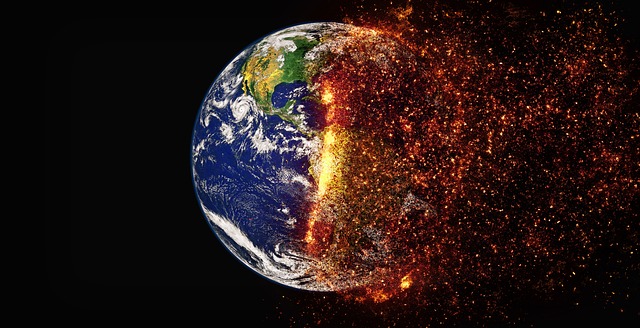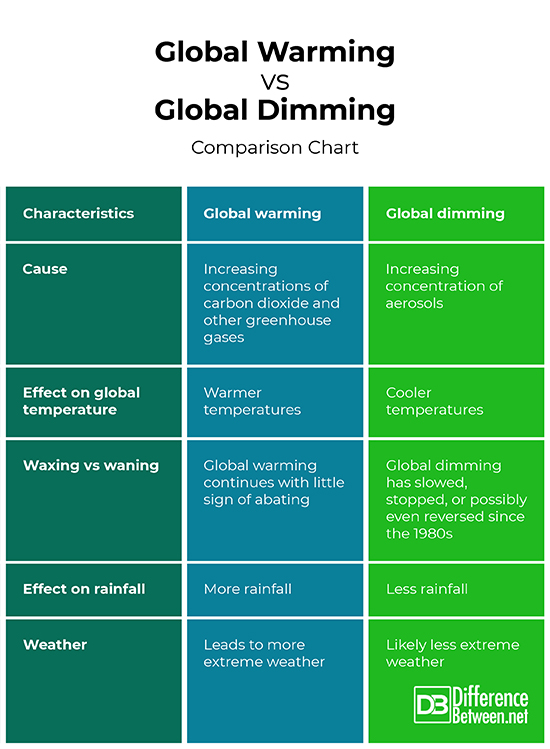Difference Between Global Warming and Global Dimming
What is Global Warming?
Global warming, or global climate change, is a climatological phenomenon in which the global temperature is rising due to the increase in greenhouse gases in the atmosphere such as carbon dioxide and methane. Over the past century, the global temperature has increased and is expected to continue increasing with implications for the future of climate.
Background for Global Warming
The phenomenon of global warming was first predicted in the 1960s. Climate scientists, such as Charles David Keeling, detected that carbon dioxide was increasing year by year around the globe. They theorized that this would lead to dramatic increases in temperature because of the heat trapping properties of carbon dioxide.
Primary Evidence for Global Warming
Direct Temperature Measurements
The primary prediction of global warming is the increase in temperature. This has been confirmed by direct measurements of temperature since the 1960s. Each year, thousands of hot temperature records are broken and the three hottest years on record are in the decade of the 2010s, the most recent decade at the time of writing.
Melting of Ice
Because of rising temperatures, most glaciers have been in retreat and most major ice sheets are decreasing in size, losing mass every year. This melting of land ice has caused concerns over rising sea level. Another concern is that mountain glaciers, especially those in the Himalayas, contain most of the fresh water supply that is the source of drinking water for many human societies.
Cause of global warming
The cause of global warming is the increase in the concentration of greenhouse gases such as carbon dioxide and methane in the atmosphere. Direct measurements of greenhouse gases show that they have been continually increasing for the past century and a half. Past records indicate that the current increase in carbon dioxide since the mid-19th century deviates from the norm for recent geological history. The most important source for data regarding the variation in carbon dioxide is the ice core data.
Ice Cores
The central plains of Greenland have very regular snowfall which produces sequential layers of ice. As these layers build up year after year, the ice becomes more compact, and air bubbles get trapped in it. These air bubbles are isolated from the modern atmosphere, so that their composition reflects whatever the composition of the ancient atmosphere was at the time that the compaction and isolation occurred.
Using ice core records, scientists have found that carbon dioxide has maintained certain levels throughout the last several hundred thousand years. Beginning in the 19th century however, carbon dioxide levels began to dramatically increase and deviate from expected levels. This increase is directly correlated with the recent increase in temperature. It is reasonable to suppose a correlation between carbon dioxide and temperature since carbon dioxide is a greenhouse gas that traps heat from the sun, thus increasing the temperature.
Global Warming as an Anthropogenic Phenomenon
The cause of the increase in carbon dioxide emissions in the past two hundred years is related to the Industrial Revolution when fossils fuels such as coal and oil began to be used to provide power for cities and machinery. Coal and oil are organic materials that form when formerly living organisms become altered under heat and pressure. When coal and oil form, the carbon that makes up the former living organisms that are now coal and oil is removed from the carbon cycle so that it is not introduced back into the atmosphere. The carbon is essentially isolated, no longer contributing to climate.
During the Industrial Revolution, however, humans began to take the coal and oil out of the ground and use it to power their machinery. During the combustion process, carbon dioxide is produced, leading to a net increase in carbon dioxide in the atmosphere and oceans. Because of fossil fuels, humans have released excessive amounts of carbon dioxide into the atmosphere. Humans started using fossil fuels on a large scale only 200 years ago and carbon dioxide levels and temperature have only been increasing, in a way that has not been the norm, for the past 200 years. This makes it likely that human activity has led to the increase in carbon dioxide emissions and other greenhouse gas emissions.
Other Consequences of Global Warming
In addition to the melting of the ice sheets and sea level rise, global warming is likely to lead to more extreme weather patterns, such as hurricanes and floods. In the past decade, there has been a slight uptick in these kinds of events, though it is unclear that this is directly due to global warming.
What is Global Dimming?
Global dimming is a phenomenon by which the amount of sunlight reaching Earth’s surface is decreasing. This phenomenon was first discovered in the 1950s and has been attributed to pollution in the atmosphere.
Causes of Global Dimming
In the process of burning fossil fuels, aerosols are produced that are very reflective. As the concentration of aerosols in the atmosphere increases, their reflectivity causes more solar radiation from the sun to be reflected. This reduces the amount of sunlight reaching the surface.
Effects of Global Dimming
Global dimming has reduced the amount of energy brought to Earth’s surface through solar radiation. This can result in a reduced water cycle and less evaporation which can lead to less rainfall. There are concerns that this may affect agriculture because of the interruption of monsoon seasons in parts of the world that rely on summer rains for growing crops. Global dimming can also affect plant growth and renewable energy efforts utilizing solar power. Since the 1980s, due to environmental policies to clean up air pollution, there has been a decrease in global dimming and some even argue that it has stopped or reversed.
Similarities Between Global Warming and Global Dimming
Global warming and global dimming are both related to the burning of fossil fuels and both can be prevented or mitigated by changing how fossil fuels are used. They also threaten to change the climate in ways that will significantly affect human societies.
Differences Between Global Warming and Global Dimming
Although there are similarities between global warming and global dimming, there are also notable differences which include the following.
- Global warming is caused by the increase in greenhouse gases such as carbon dioxide due to the burning of fossil fuels, whereas global dimming is the result of the aerosols produced as a byproduct of burning fossil fuels.
- Global warming leads to increased temperature, while global dimming should in theory lead to lower temperatures.
- Global dimming has slowed, stopped, or possibly even reversed since it was first discovered, whereas global warming continues.
- Global warming leads to increased rainfall because of evaporating oceans, whereas global dimming leads to less rainfall due reduced evaporation.
- Global warming will lead to more severe weather, whereas global dimming leads to calmer weather since less energy in the water cycle will mean fewer storms.
Global Warming vs. Global Dimming: Comparison Chart
Summary of Global Warming vs. Global Dimming
Global warming is a phenomenon whereby Earth’s global atmospheric temperature is increasing, leading to melting ice sheets, higher sea level, and more extreme weather. It is primarily caused by an increase in the concentration of anthropogenic greenhouse gases such as carbon dioxide. Global dimming is a phenomenon whereby increasingly less sunlight has reached Earth’s surface because of the increase in the production of aerosols as a byproduct of the burning of fossil fuels. Both global warming and global dimming are related to fossil fuels and both will have significant impacts on human societies if they continue unabated. Despite these similarities, the two phenomena are different in that one leads to warmer temperatures while the other should lead to cooler temperatures. It is possible that global dimming may have offset global warming so that the planet has not warmed as much as it otherwise would have. Another important difference is that global dimming seems to be decreasing or may have stopped whereas global warming continues to have a significant impact on the planet and on human civilization.
- Difference Between Environmental Performance Index and Development - November 24, 2023
- Difference Between Environmental Intervention and Development - November 8, 2023
- Difference Between Eco Efficiency and Eco Effectiveness - September 18, 2023
Search DifferenceBetween.net :
Leave a Response
References :
[0]Harris, Daniel C. "Charles David Keeling and the story of atmospheric CO2 measurements." (2010): 7865-7870.
[1]Oerlemans, Johannes. "Quantifying global warming from the retreat of glaciers." Science 264.5156 (1994): 243-245.
[2]Vaughan, David G., et al. "Observations: cryosphere." Climate change 2103 (2013): 317-382.
[3]Alley, Richard B. The Two-Mile Time Machine: Ice Cores, Abrupt Climate Change, and Our Future-Updated Edition. Princeton University Press, 2014.
[4]Alley, Richard B. The Two-Mile Time Machine: Ice Cores, Abrupt Climate Change, and Our Future-Updated Edition. Princeton University Press, 2014.
[5]Schiermeier, Quirin. "Increased flood risk linked to global warming." (2011): 316-316.
[6]Anthes, Richard A., et al. "Hurricanes and global warming—Potential linkages and consequences." Bulletin of the American Meteorological Society 87.5 (2006): 623-628.
[7]Wild, Martin. "Global dimming and brightening: A review." Journal of Geophysical Research: Atmospheres 114.D10 (2009)
[8]Stanhill, Gerald, and Shabtai Cohen. "Global dimming: a review of the evidence for a widespread and significant reduction in global radiation with discussion of its probable causes and possible agricultural consequences." Agricultural and forest meteorology 107.4 (2001): 255-278.
[9]Image credit: https://pixabay.com/es/cambio-climático-2254711/
[10]Image credit: https://pixabay.com/es/cambio-climático-2063240/



